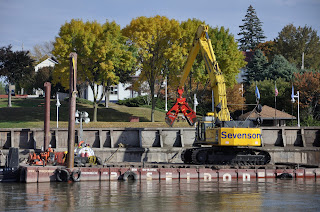 Approximately 300,000 cubic yards of sediment (equivalent to 15,000 dump trucks full) contaminated with PCBs and PAHs were removed from the river between August 2012 and early January 2013. As a result, river-goers will enjoy a deeper river with better navigation and access, and a cleaner habitat for fish and wildlife to thrive.
Approximately 300,000 cubic yards of sediment (equivalent to 15,000 dump trucks full) contaminated with PCBs and PAHs were removed from the river between August 2012 and early January 2013. As a result, river-goers will enjoy a deeper river with better navigation and access, and a cleaner habitat for fish and wildlife to thrive. IISG’s Caitie McCoy worked with a local team throughout 2012 to provide information to stakeholders and the public on the project. She completed a study in March (PDF) with University of Illinois student Ada Morgan to learn how to communicate the sediment remediation project and its benefits to the public. The study helped the team tailor outreach products and messaging for everyone who uses and visits the river.

